“There was a time when India’s food security was a global concern, today India is providing solutions for global food and nutrition security.”
~Prime Minister Narendra Modi
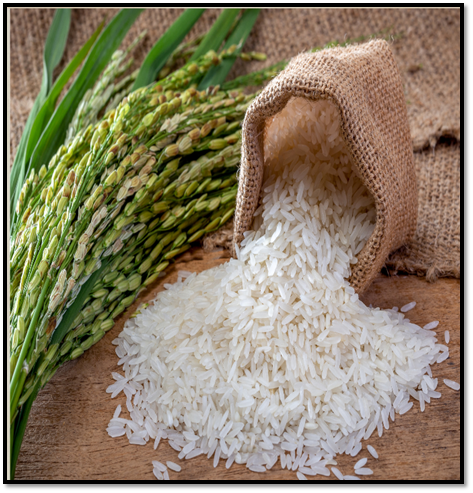 During India’s 75th Independence Day, Prime Minister Shri Narendra Modi emphasised the need to combat malnutrition, underscoring that every citizen, especially the underprivileged, deserves access to nutritious food for a healthier, stronger India.
During India’s 75th Independence Day, Prime Minister Shri Narendra Modi emphasised the need to combat malnutrition, underscoring that every citizen, especially the underprivileged, deserves access to nutritious food for a healthier, stronger India.
In line with this vision, the Government of India is committed to ensuring the holistic nutritional well-being of the people. The Cabinet’s recent approval to distribute fortified rice under all government schemes marks a significant milestone in realizing the Prime Minister’s vision for a malnutrition-free India.
Extension of Rice Fortification
The Cabinet has taken a pivotal decision to extend the universal supply of fortified rice under all government welfare schemes, including the Pradhan Mantri Garib Kalyan Anna Yojana (PMGKAY), from July 2024 until December 2028.
The Cabinet has approved the continuation of the following:
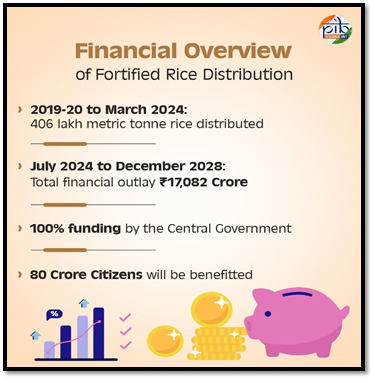
- Rice fortification initiative beyond June 2024 and up to 31.12.2028.
- Implementation of the Rice Fortification initiative under the various schemes of the government as a Central Sector Initiative to be 100% funded by the Government of India.
- Existing mechanism of meeting the cost towards the supply of fortified rice as a part of PMGKAY (Food Subsidy) under the already approved allocation of ₹11,79,859 Cr of the PMGKAY Scheme.
This initiative aims to provide vulnerable populations with enhanced nutrition by distributing fortified rice enriched with essential micronutrients such as iron, folic acid, and vitamin B12. The distribution will follow the standards set by the Food Safety and Standards Authority of India (FSSAI).
According to the World Health Organization’s meta-analysis, rice fortification can reduce the risk of iron deficiency by 35%. With an estimated annual outlay of INR 2,565 crore, this initiative has the potential to avert 16.6 million Disability-Adjusted Life Years (DALYs) per year, resulting in healthcare savings equivalent to INR 49,800 crore in GDP terms. The cost implications for the Public Distribution System (PDS) are seen as a valuable investment in improving citizens’ health.
Since the launch of the rice fortification pilot scheme in 15 states in 2020, the program has seen significant progress. Between 2019-20 and March 31, 2024, approximately 406 lakh metric tonnes of fortified rice were distributed through the PDS, enhancing the nutritional intake of millions across the country.
Expansion Over the Years
- Feb 2016: MoWCD (Ministry of Women and Child Development) highlighted rice fortification to combat malnutrition and anaemia, focusing on children, pregnant women, and lactating mothers, with involvement from key stakeholders like Ministry of Health and Family Welfare (MoHFW), Food Corporation of India (FCI), National Institute of Nutrition (NIN), Indian Council of Medical Research (ICMR), and the Food Safety and Standards Authority of India (FSSAI). A task force by the Ministry recommended mandatory rice fortification in government programs via FCI, with phased implementation in May 2016.
- Mar 2018: NITI Aayog, FCI, and Department of Food & Public Distribution proposed fortifying rice and wheat flour for ICDS and MDM (Mid-Day Meal). FSSAI was tasked with preparing a food fortification progress report.
- New India @75: Advocated mandatory fortification of staples and their inclusion in government programs like ICDS, PM POSHAN, and TPDS.
- 2019-2022: Centrally Sponsored Pilot Scheme launched with a ₹174.64 crore budget. By March 2022, 4.30 Lakh Metric Tonnes of fortified rice were distributed in 11 states.
- Aug 2021: Prime Minister announced rice fortification in government welfare schemes.
- 2022: Cabinet Committee on Economic Affairs (CCEA) approved phased national rollout and supply of Fortified rice under targeted public distribution system (TPDS) and
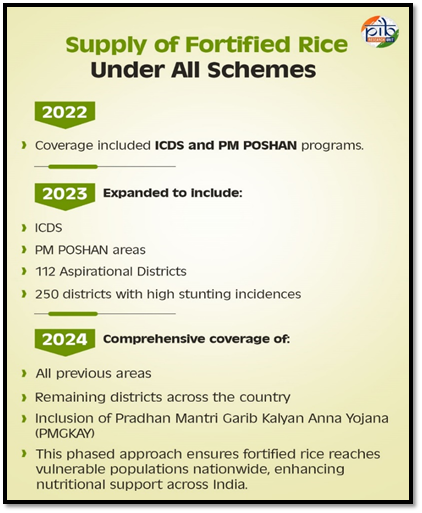 Other Welfare Schemes (OWS) as Central Sector Initiative (100% GoI funds) up to 30.06.2024 with a proposed expenditure of Rs.4269.76 cr.
Other Welfare Schemes (OWS) as Central Sector Initiative (100% GoI funds) up to 30.06.2024 with a proposed expenditure of Rs.4269.76 cr. - Phase I (2021-2022): Covered Integrated Child Development Services (ICDS) and PM POSHAN.
- Phase II (2022-2023): Added TPDS (Targeted Public Distribution System) and OWS (Other welfare Schemes) in 291 districts.
- Phase III (2023-2024): Extended to remaining districts.
- March 2024: 100% coverage of the distribution of fortified rice has been achieved, and custom-milled rice has been replaced with fortified rice under all government schemes.
Custom-milled rice has been replaced with fortified rice in every scheme of the Government and 100% coverage of distribution of fortified rice has been achieved by March, 2024
Food Fortification in India
Fortification is the process of enriching food with essential micronutrients, such as vitamins and minerals, to improve its nutritional value. Food fortification has been used globally as a safe and effective measure to address anaemia and micronutrient malnutrition in the vulnerable population. According to the 2008 Copenhagen Consensus, food fortification is one of the top three priorities for developing nations and plays a vital role in combating malnutrition. In India, fortification has proven successful in the past. For instance, iodized salt has significantly reduced iodine deficiency and diseases like goitre.
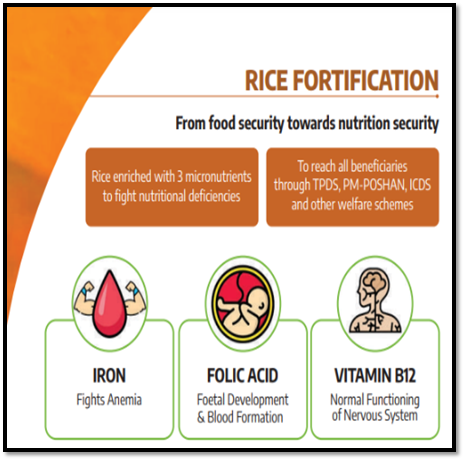 According to the National Family Health Survey (NFHS-5) conducted between 2019 and 2021, anaemia remains a prevalent issue in India. In addition to Iron deficiency, other vitamin-mineral deficiencies such as Vitamin B12 and Folic acid continue to co-exist and affect the health and productivity of the population.
According to the National Family Health Survey (NFHS-5) conducted between 2019 and 2021, anaemia remains a prevalent issue in India. In addition to Iron deficiency, other vitamin-mineral deficiencies such as Vitamin B12 and Folic acid continue to co-exist and affect the health and productivity of the population.
To address these challenges, the government has undertaken significant steps, including the distribution of fortified rice. In India, rice is a staple for 65% of the population. This makes it an ideal medium for delivering essential nutrients. The process involves adding Fortified Rice Kernels (FRK) to regular custom-milled rice, following standards prescribed by the Food Safety and Standards Authority of India (FSSAI). Through rice fortification, the government aims to quickly enhance the nutritional intake of millions, especially the undernourished.
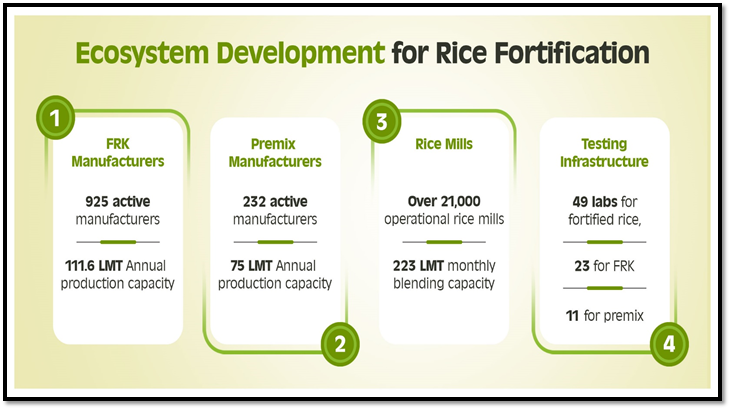
Enhancing Nutrition in India
In addition to supplying fortified rice, the Government of India has launched various schemes and programs across different ministries and departments to enhance nutritional intake and promote healthy living nationwide. These initiatives address various aspects of malnutrition and emphasize direct nutritional interventions, particularly for vulnerable populations. Major Nutrition Schemes:
Since 2018, Poshan Maah (Prime Minister’s Overarching Scheme for Holistic Nourishment) and Poshan Pakhwada have been held across the country, enhancing nutrition outcomes for children, pregnant women, and lactating mothers. These events aim to raise awareness about nutrition and healthy eating. Poshan Maah 2024 particularly emphasized key areas related to nutrition, with 97.69 lakh activities dedicated to promoting healthy eating practices, improving dietary diversity, and educating communities about locally available nutritious foods.
It is a centrally sponsored scheme that provides financial support to pregnant women and lactating mothers. It aims to compensate for wage loss and encourage proper nutrition and rest during pregnancy.
Launched on 2nd October, 1975 this umbrella scheme includes Anganwadi Services and the Scheme for Adolescent Girls to provide supplementary nutrition to beneficiaries. The scheme ensures that children, pregnant women, and lactating mothers receive adequate nutrition through supplementary feeding programs.
Formerly known as the Mid-Day Meal Scheme, this program aims to enhance the nutritional status of school children, thereby supporting their physical and cognitive development. The Hon’ble Prime Minister has approved the continuation of the national PM POSHAN scheme in schools for a five-year period, from 2021-22 to 2025-26. The financial allocation for this initiative includes ₹54,061.73 crores from the Central Government and ₹31,733.17 crores from State Governments and UT administrations. Additionally, the Central Government will cover an extra cost of approximately ₹45,000 crores for food grains. As a result, the total budget for the scheme will amount to ₹130,794.90 crores.
The Pradhan Mantri Garib Kalyan Anna Yojana (PMGKAY) was introduced to help alleviate the difficulties faced by the poor and needy due to the economic disruptions caused by the COVID-19 pandemic. This initiative aims to provide free food grains to around 81.35 crore beneficiaries.
Conclusion
Recognizing the critical role of nutrition in building a healthier nation, the Cabinet’s approval to continue this program marks a significant step in addressing malnutrition and enhancing the well-being of millions. As nation’s strive to achieve Sustainable Development Goal 2 of ending malnutrition in all its forms, India’s rice fortification programme is one of the most effective complementary interventions to tackle nutritional anaemia. By fortifying the rice provided through these programs, the government aims to support the nutritional needs of the underprivileged, fostering a stronger, healthier India.
 Matribhumi Samachar English
Matribhumi Samachar English


